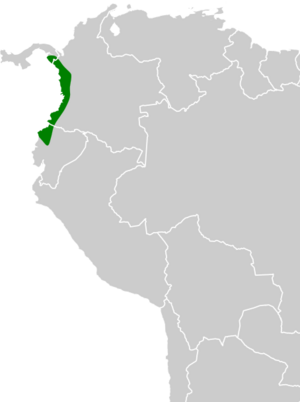Black-tipped cotinga facts for kids
Quick facts for kids Black-tipped cotinga |
|
|---|---|
 |
|
| Conservation status | |
| Scientific classification | |
| Genus: |
Carpodectes
|
| Species: |
hopkei
|
 |
|
The black-tipped cotinga is a beautiful bird also known as the white cotinga. It belongs to the Cotingidae family. You can find this bird in the Chocó region, which stretches from southeastern Panama to northwestern Ecuador. It lives in warm, wet forests close to sea level. The male birds are bright white and easy to spot, but overall, this species is not very common.
Contents
What Does the Black-tipped Cotinga Look Like?
This bird grows to be about 9 to 10 inches (23 to 25 cm) long. It has a black beak, red eyes, and short, rounded wings.
Males and Females Look Different
The male black-tipped cotinga is almost completely pure white. The only dark parts are small black tips on its outer wing feathers. Younger males might also have a black tip on their central tail feathers.
Female black-tipped cotingas look very different! Their head and upper body are brownish-grey. Their wings and tail are brownish-black. However, the feathers covering their wings and the inner flight feathers have wide white edges. Their belly is white, and the rest of their underside is a pale grey.
How Does the Black-tipped Cotinga Behave?
The male's bright white feathers make it very easy to see. You might spot it sitting on a high branch above the trees or flying slowly in big loops.
These birds are more social than some of their relatives. They often fly together in groups that include both males and females. Scientists have not yet heard any special songs or calls from this bird.
Is the Black-tipped Cotinga in Danger?
The total number of black-tipped cotingas is not known exactly, but experts believe their population is shrinking. This is mainly because the lowland forests where they live are being destroyed, especially in Ecuador.
Even though their numbers are going down, this bird is not yet considered a vulnerable species. The black-tipped cotinga lives across a very large area. Because of this wide range, the International Union for Conservation of Nature (IUCN) has listed it as a "least-concern species". This means they don't believe the decline in its habitat or total population is serious enough to put it in a more threatened category right now.


